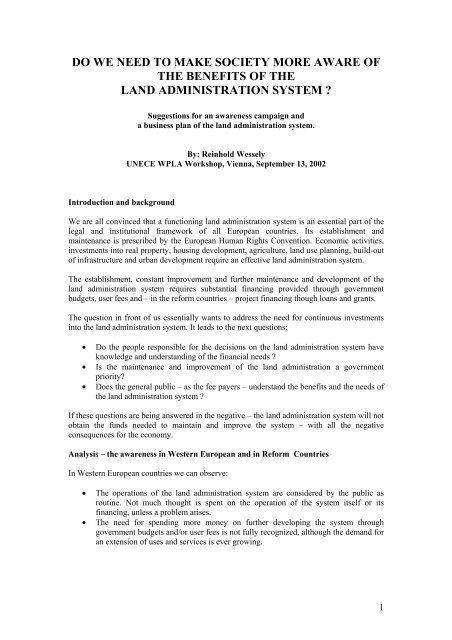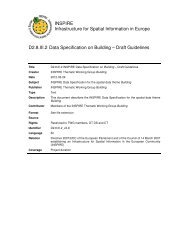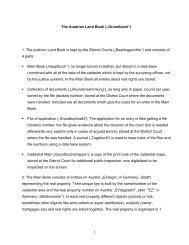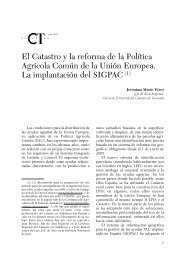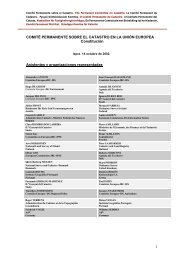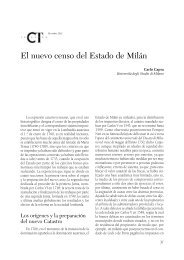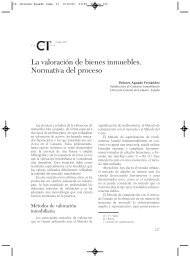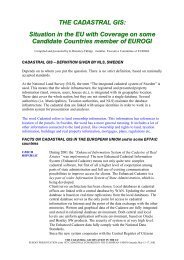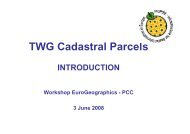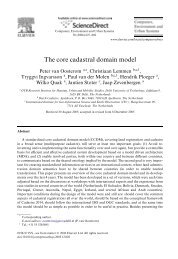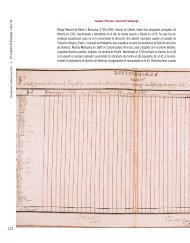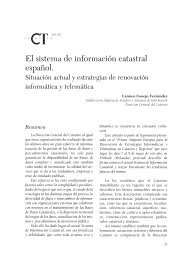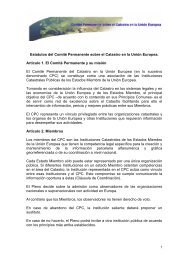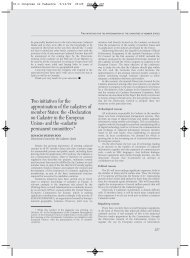IS SOCIETY AWARE OF THE LAND
IS SOCIETY AWARE OF THE LAND
IS SOCIETY AWARE OF THE LAND
Create successful ePaper yourself
Turn your PDF publications into a flip-book with our unique Google optimized e-Paper software.
DO WE NEED TO MAKE <strong>SOCIETY</strong> MORE <strong>AWARE</strong> <strong>OF</strong><br />
<strong>THE</strong> BENEFITS <strong>OF</strong> <strong>THE</strong><br />
<strong>LAND</strong> ADMIN<strong>IS</strong>TRATION SYSTEM ?<br />
Introduction and background<br />
Suggestions for an awareness campaign and<br />
a business plan of the land administration system.<br />
By: Reinhold Wessely<br />
UNECE WPLA Workshop, Vienna, September 13, 2002<br />
We are all convinced that a functioning land administration system is an essential part of the<br />
legal and institutional framework of all European countries. Its establishment and<br />
maintenance is prescribed by the European Human Rights Convention. Economic activities,<br />
investments into real property, housing development, agriculture, land use planning, build-out<br />
of infrastructure and urban development require an effective land administration system.<br />
The establishment, constant improvement and further maintenance and development of the<br />
land administration system requires substantial financing provided through government<br />
budgets, user fees and – in the reform countries – project financing though loans and grants.<br />
The question in front of us essentially wants to address the need for continuous investments<br />
into the land administration system. It leads to the next questions:<br />
• Do the people responsible for the decisions on the land administration system have<br />
knowledge and understanding of the financial needs ?<br />
• Is the maintenance and improvement of the land administration a government<br />
priority?<br />
• Does the general public – as the fee payers – understand the benefits and the needs of<br />
the land administration system ?<br />
If these questions are being answered in the negative – the land administration system will not<br />
obtain the funds needed to maintain and improve the system – with all the negative<br />
consequences for the economy.<br />
Analysis – the awareness in Western European and in Reform Countries<br />
In Western European countries we can observe:<br />
• The operations of the land administration system are considered by the public as<br />
routine. Not much thought is spent on the operation of the system itself or its<br />
financing, unless a problem arises.<br />
• The need for spending more money on further developing the system through<br />
government budgets and/or user fees is not fully recognized, although the demand for<br />
an extension of uses and services is ever growing.<br />
1
• Private parties, businesses, intermediaries (as notaries, surveyors, attorneys, banks),<br />
but also other public agencies, increasingly need the services of the system, whereas<br />
the understanding of financing such needs is rather underdeveloped.<br />
In the reform countries, additional problems exist:<br />
• People are not entirely familiar with the land administration system.<br />
• In some instances, registration is avoided, due to the high costs of using the system.<br />
• In most countries, registration of real property rights is based on application of the<br />
parties which makes it easy to skip the use with the negative consequences of loosing<br />
rights discovered at a later date and ensuing disputes.<br />
The dangers of such conditions are manifold. Necessary investments for the improvement,<br />
maintenance, improvement and further development are difficult to finance. As a result,<br />
services need to be reduced or – conveniently – further privatization of services is called for<br />
which might lead to less accuracy, less timeliness of data availability, or less reliability of<br />
data necessary for economic activities and transactions, or – to avoid that – to a substantial<br />
increase in the user fees.<br />
Personal opinion on privatization of land administration services<br />
At this point I want to express a personal opinion on the ongoing discussion about<br />
privatization of land administration services. This opinion is based on observations made as<br />
advisor or project manager in a variety of countries in Central and Eastern Europe and Central<br />
Asia.<br />
I recognize that in some countries the Government is reluctant for various reasons (politics,<br />
incompetence, lack of funds) to set priorities for the improvement and further modernization<br />
of the land administration. “If it is not broke, do not fix it.”<br />
On the other hand, the private sector might be more effective to run a land administration<br />
system - or parts thereof – but is much more susceptible to (1) overcharging for services<br />
(which would lead to an “under-use” of the system with all the consequences) or (2)<br />
corruption. Control mechanism are difficult to establish and to maintain. For all of these<br />
reasons, I would plead for a general model which could briefly described as follows:<br />
• The core functions, such as the establishment and maintenance of the basic physical<br />
property data, always should remain in the domain of the Government, or a<br />
government agency. Incorporation of a government entity is not considered as being<br />
privatized. As, nowadays, surveying itself, is outsourced, licensed (and, thus,<br />
controlled) surveyors can provide such services.<br />
• At the “point-of-sale”, i.e. the point where legally acquired (and paid for) data are<br />
further used and disseminated, private entities can start their commercial endeavors of<br />
using data for various purposes as land use planning, construction, agriculture,<br />
housing development.<br />
• The distribution of data through technical (electronic) means, such as the internet, can<br />
be outsourced with the caveat that the “ownership” of data always remains in the<br />
public domain.<br />
• The “ownership of data” by the public domain means that such data can be sold to<br />
intermediaries for (1) information to interested parties and (2) for further use and<br />
development against compensation. Such revenues will enable the public domain to<br />
maintain, develop and improve its database.<br />
2
The table below describes the scheme discussed above.<br />
Table 1<br />
Public domain Private domain<br />
Registration of rights<br />
Basic property data<br />
Information on<br />
data<br />
Why do land administration institutions need a marketing plan ?<br />
Further use of data<br />
Land administration systems still – to a large extent – are financed by government budgets.<br />
Increasingly, budgets are restricted by austerity measures and determined by – sometimes<br />
more glamorous – political priorities. The collection of fees for the use of the system in many<br />
instances also is limited for popular political reasons. As a result of the limitation of<br />
resources, services might have to be reduced, services privatized and the overall quality and<br />
the extent of the services provided by the land administration system might suffer.<br />
In the reform countries, the reconstruction of the land administration system is not completed<br />
yet and needs a huge amount of funding through budgets, international programs and loans<br />
and fees.<br />
In order to overcome these deficiencies, the land administration system needs to turn to the<br />
decision maker in a professional manner to create understanding of the underlying problems<br />
and to influence the decisions by arguments. A business / marketing plan is the professional<br />
tool for such a campaign.<br />
Suggestions for a business / marketing plan<br />
A business plan of a land administration system is a joint effort of all institutions, public and<br />
private, involved. The first step, therefore, is to create a community of joint interests between<br />
the government agencies (cadastre and real property registration agency) and the private<br />
sector intermediaries, as notaries, surveyors, attorneys, realtors and banks. Such a concerted<br />
effort also would make the funding of any campaign easier.<br />
A business plan of a land administration system has to determine (1) the target group to<br />
whom the efforts are directed, (2) the products and services provided, (3) the tools and<br />
instruments used for the operation and (4) the desired results of the business.<br />
Target groups<br />
Obviously, a land administration system in its effort to win understanding has to address<br />
several different groups: (1) the parliament and governmental institutions which decide on its<br />
budget, (2) the general public which has to understand that the operations and the<br />
development of the land administration system has to be financed increasingly by user fees,<br />
and (3) special partners, as the notaries, attorneys, surveyors, realtors, banks as their business<br />
is closely related – and dependent upon – the functioning of the land administration system.<br />
3
Products and services<br />
The products and services offered by the land administration system – in part as through<br />
outsourcing of the original services, or through public/private partnership constructs – and the<br />
benefits to the target groups constitute the arguments used in a business plan and marketing<br />
campaign. Such a campaign has to explain – on a cost/benefit basis – how important and<br />
beneficial the products and services provided are for the overall economy and for special<br />
interests of the target group.<br />
Desired results<br />
Such a campaign should achieve the following results:<br />
• Increased budget for maintenance of and further investments into the land<br />
administration system.<br />
• Better understanding of the general public – the clients of the land administration<br />
system – for the financial needs of the system.<br />
• Increase of investments into the land administration system will lead to technical<br />
improvement and, thus, can serve better the clients’ demands.<br />
• Increase and improvement of services of the land administration system.<br />
A marketing concept for a land administration system – a business approach<br />
In order to conduct an effective marketing (awareness) campaign as described above, the land<br />
administration system should develop a business plan similar to any commercial entity. It<br />
starts with the identification of its position in its specific market as schematically shown on<br />
the table below.<br />
Table 2<br />
4
The land administration system which is historically determined by government structures<br />
and methods of operation has to assume the character of a business in terms of management,<br />
clients (not applicants), products and services (tailored to the needs of the clients), pricing of<br />
products and services based on costs (cost recovery) or values perceived, on revenues to<br />
obtain for the lifelong existence of the system.<br />
Consumer market vs. producer market<br />
Historically, a land administration system produced products according to a legal command. It<br />
was a distribution of a product, not a service provided upon the demand of clients. In a<br />
modern, democratic society citizens have become clients. And, thus, also a land<br />
administration system has to ask for what its clients want and need. People expect from the<br />
land administration system immediate execution of the application (for registration), or<br />
prompt availability of information which has to be accurate and cheap. At the same time,<br />
though, clients do not recognize easily any more the value (and the related costs) of preparing<br />
and maintaining the core functions and data of the cadastre and the real property rights<br />
registration institutions, because they use the privatized services of intermediaries (notaries,<br />
surveyors, attorneys, realtors, banks).<br />
Analysis of needs<br />
An analysis of the needs of the land administration system clients probably (it should be<br />
ascertained by a professional marketing survey) would yield the following results:<br />
• Security of real property rights and real property data.<br />
• Confidence into the land administration system with regard to completeness and<br />
reliability of data.<br />
• Full information on and transparency of data of transactions and registration status.<br />
• Accuracy of data and timeliness of data availability.<br />
• Affordability of using the land administration system.<br />
Analysis of products and services<br />
The principal products and services the land administration services can offer are:<br />
• Cadastre: establishment and maintenance of data (inventory).<br />
• Real property rights registration institution: establishment of rights.<br />
• Access to data through modern information technology (jnternet).<br />
• Further use of data for market information, land use planning and control.<br />
Analysis of competitors<br />
Although the core of the land administration system is in the public domain, and, thus,<br />
constitutes a monopoly, certain, privatized peripheral functions might develop faster than the<br />
core basis which is being neglected or underdeveloped due to lack of funds. To remedy the<br />
situation, the relationship between the public domain core function and the privatized<br />
peripheral services has to be monitored and a balanced development has to be secured. The<br />
land administration system has to be kept competitive by innovation through new investments<br />
into technology and the customer orientation of services. A business plan as the instrument to<br />
meet these challenges has to be developed.<br />
5
The lifeline of an enterprise<br />
In the business world we are used to cyclical development of a business. From a modest startup<br />
a business is being developed to the peak of its existence. It is there where complacency<br />
sets in and competitors start to attack the market position. If the warning signs are not seen<br />
early enough, a business will slide down the path to death. The critical (turning) point in this<br />
development is at the peak where new products and services, new clients or other new<br />
innovative means have to be developed to stay alive. These rules also are valid for a land<br />
administration system, although the process of development might differ in terms of time and<br />
absoluteness of sequences, but the pattern itself should be a warning to consider always new<br />
ways, products and services and approaches to stay in business for the clients.<br />
Table 3<br />
This schematic graph illustrates the above.<br />
In the core of a business plan are the goals of an entity. The following is an attempt to<br />
describe potential goals – in a traditional hierarchy of goals – of a land administration system.<br />
Mission, goals and strategies<br />
Table 4<br />
6
Mission of a land administration system<br />
The mission of a land administration system is:<br />
• Administration of all functions related to land (real property, i.e. the physical space<br />
needed for food and shelter, the protection of nature, the cultural roots of a society).<br />
• Implementation of (otherwise) abstract rights of subjects on (physically) defined real<br />
property objects.<br />
• Application of economic measurements to objects through a valuation process needed<br />
to facilitate transactions, to develop a land market and to enable property based<br />
taxation.<br />
Goals of a land administration system<br />
The goals of a land administration system can be determined along the TOR of the UNECE<br />
WPLA Guidelines in essence as follows:<br />
• To guarantee (private) real property ownership, security of tenure and other rights<br />
(such as mortgages) on real property.<br />
• To facilitate real property transactions through simple and efficient, transparent and<br />
affordable procedures.<br />
• To improve land use planning and control and infrastructure development.<br />
• To promote maintenance and improvement of buildings, particularly of housing.<br />
• To protect the environment.<br />
Sample strategies for a land administration system<br />
Strategies have to be developed on how to achieve these goals. Highlights of such sample<br />
strategies are:<br />
• Land reform: privatization, consolidation, agricultural land.<br />
• Land policies: spatial planning, land use and urban planning.<br />
• Cadastre modernization.<br />
• Real property rights registration system.<br />
• Land market promotion.<br />
Marketing instruments<br />
We have several instruments for the marketing of the land administration services at our<br />
disposal:<br />
• First, we clearly have to define what products and services the land administration<br />
system can provide to whom at what price.<br />
• The organizational set-up and the institutional arrangements, including privatization<br />
of services, partnerships and outsourcing of services, will determine costs,<br />
effectiveness and client orientation of the land administration system.<br />
• The pricing policy of the land administration system can be based on either (1) cost<br />
recovery or on (2) the perceived value of the products and services provided.<br />
• Investments into the system have to be evaluated with classical methods as return on<br />
investment and cost recovery calculations.<br />
7
• Information of clients and the relationship with target groups are essential marketing<br />
instruments for identifying, acquiring and keeping clients.<br />
Summary conclusions<br />
From the above, clear conclusions can be drawn:<br />
We need to make aware the government (as the provider of budget funds), the general public<br />
(as the users and fee payers) and the special partners of the benefits of the land administration<br />
system in order to secure ongoing – and potentially increasing – funding for further<br />
improvement of the land administration system by emphasizing the benefits for the economic<br />
and social development of the country and its society.<br />
8


